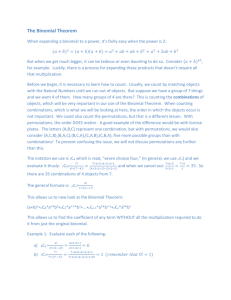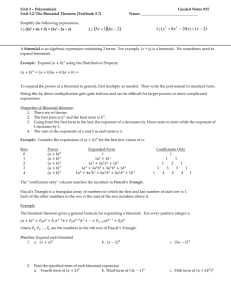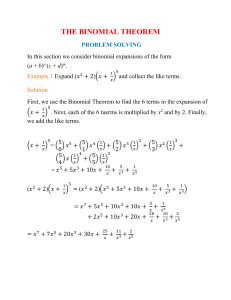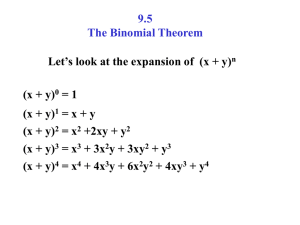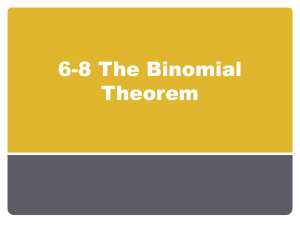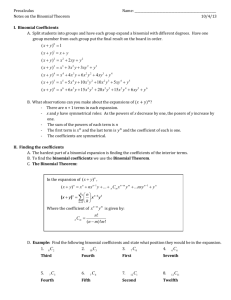Binomial Theorem 3 Unit Maths
advertisement
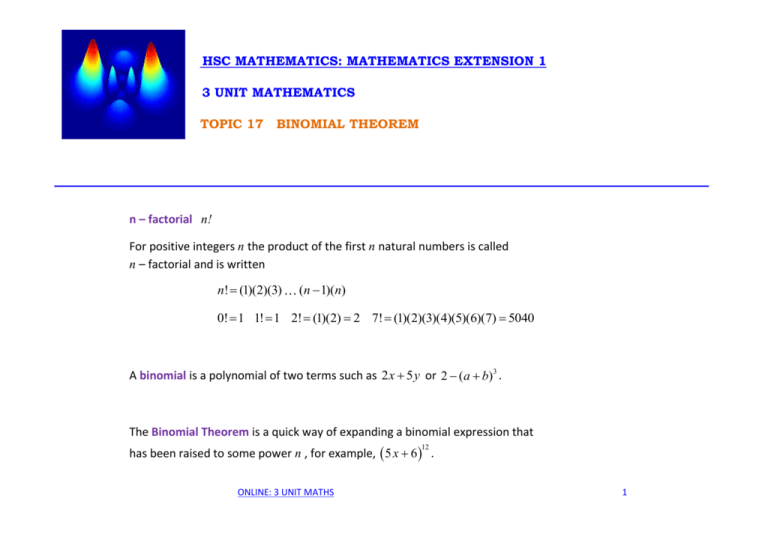
HSC MATHEMATICS: MATHEMATICS EXTENSION 1 3 UNIT MATHEMATICS TOPIC 17 BINOMIAL THEOREM n – factorial n! For positive integers n the product of the first n natural numbers is called n – factorial and is written n! (1)(2)(3) (n 1)(n) 0! 1 1! 1 2! (1)(2) 2 7! (1)(2)(3)(4)(5)(6)(7) 5040 A binomial is a polynomial of two terms such as 2 x 5 y or 2 (a b)3 . The Binomial Theorem is a quick way of expanding a binomial expression that has been raised to some power n , for example, 5 x 6 . 12 ONLINE: 3 UNIT MATHS 1 Consider the polynomial ( x y)n where n is an integer n 1, 2, 3, This polynomial can be expanded using the Binomial Theorem in terms of the n binomial coefficients nCk n 1,2, 3, 0k n k n k is read as ‘n over k’ n n n! Ck k k ! n k ! n 4 4 n C0 1 0 4 C0 1 0 0 4 0k n 0 C0 1 0 n n n n n! Ck n Cn k k n k k ! n k ! n Cn 1 n 4 (4)(3)(2)(1) C1 4 4C3 1 (1)(3)(2)(1) 4 (4)(3)(2)(1) C3 4 4C1 3 (1)(2)(3)(1) 4 4 4 (4)(3)(2)(1) C2 6 2 (1)(2)(2)(1) 4 C4 1 4 ONLINE: 3 UNIT MATHS 2 Pascal’s triangle An easy way to calculate the binomial coefficients is to use Pascal’s Triangle where the binomial coefficients are arranged in a triangle. Each interior number is the sum of the nearest two numbers in the previous row. ONLINE: 3 UNIT MATHS 3 6 6 (6)(5)(4)(3)(2)(1) 6 (6)(5)(4)(3)(2)(1) 1 6 15 6 5 4 (5)(4)(3)(2)(1)(1) (4)(3)(2)(1)(1)(2) 6 (6)(5)(4)(3)( 2)(1) 6 (6)(5)(4)(3)(2)(1) 20 15 3 2 (3)(2)(1)(1)(2)(3) (2)(1)(1)(2)(3)(4) 6 (6)(5)(4)(3)(2)(1) 6 6 1 0 1 (1)(1)(2)(3)( 4)(5) The construction of a Pascal Triangle is based upon the relationship between binomial coefficients n Ck n1 Ck 1 n1 Ck 1 k n 1 This is known as Pascal’s Triangle Identity. Example LHS 6C2 15 RHS 5 C1 5 C2 5 10 15 LHS RHS ONLINE: 3 UNIT MATHS 4 n Proof n Ck k 1 Ck n1 Ck 1 n1 Ck n! k ! n k ! n C1 1 k n 1 1 k n n! n 1! n 1! n 1 C0 n1 C1 1 n 1! 1 n 1 n 1! n 2 ! QED k2 n 1 n 1! n 1! k 1! n k ! k ! n k ! n 1! 1 1 n 1! k n k k 1! n k ! n k k k 1! n k ! (k )(n k ) Ck 1 n1 Ck n! n Ck k ! n k ! QED The coefficients of the variables x and y in the expansion of x y are called the binomial n coefficients. The (k+1)th binomial coefficient of order n ( n a positive integer) is n n n n! Ck k k ! n k ! (k+1)th binomial coefficient n Ck gives the number of combinations of n things k at a time. k ONLINE: 3 UNIT MATHS 5 Binomial Theorem n 1 ( x y) x x n n n 1 n y x n2 y 2 2 n n1 x y yn n 1 n nk k k n n ( x y) x y Ck x n k y k k 0 k k 0 k n n Example Expand the binomial expression (a b)6 Construct a Pascal Triangle to find the binomial coefficients (a b)6 a6 6a5 b 15a 4 b2 20a3 b3 15a 2 b4 6ab5 b6 The sum of the binomial coefficients is equal to 2n and is obtained by setting x y 1 n6 (1 1) 2 6 6 k n n k 0 k ONLINE: 3 UNIT MATHS 1 6 15 20 15 6 1 64 6 The binomial theorem is proved by induction. That is, it is shown to hold for n = 1, and further shown that if it holds for any given value of n then it also holds for the next higher value of n. n nk k ( x y) x y k k 0 n Suppose ( x y ) x nk y k is true. Now consider k 0 k k n k n n x y n 1 n x y x y n n n x y x nk y k k 0 k n n n n x n1k y k x n j y j 1 k 0 k j 0 j n n 1 n n n n x n1 x n1k y k y n1 x n j y j 1 k 1 k j 0 j 0 n Let j k 1 k j 1 x y n 1 x n 1 y n 1 n n1k k n n n1k k x y y x k 1 k k 1 k 1 n n n n1k k y x k 1 k k 1 n 1 n n Using Pascal's Identity k k 1 k n n 1 n 1 n 1 n1k k n1k k n 1 x y y x y x n1 y n1 x k k k 1 k 0 x n 1 y n 1 n ONLINE: 3 UNIT MATHS QED 7 Example (a) Use the binomial theorem to expand 2 3 x . 5 (b) What is the 4th term in the expansion for increasing powers of x? (c) Find the largest coefficient in the expansion. (d) Expand 2 3 x 5 (e) Use the binomial theorem to differentiate the function y 2 3 x 5 (f) Use the binomial theorem to integrate y 2 3 x from x = 0 to x = 1. 5 (a) Always write down the binomial theorem to start answering the question ( x y) 5 nk k x y k 0 k 2 3 x 5 5 k k 2 3 x k k 0 k k 5 5 5 k 5 5 Use Pascal’s triangle to give the binomial coefficients 1 5 10 10 5 1 k 2 3 x 5 (1)(25 )(1) (5)(24 )(3) x (10)(23 )(32 ) x 2 (10)(22 )(33 ) x3 (5)(2)(34 ) x 4 (1)(35 ) x5 32 240 x 720 x 2 1080 x3 810 x 4 243x5 ONLINE: 3 UNIT MATHS 8 (b) increasing powers of x: 4th term x0 x1 x2 x3 x4 5 5 3 3 t4 2 3 x3 1080 x 3 3 x5 4th term k 3 in agreement with part (a) (c) Let the coefficients be represented by ak . Since x and y are positive, we can check whether the coefficients are increasing or decreasing by considering the ratio ak 1 / ak If ak 1 / ak 1 ak 2 / ak 1 1 ak ak 1 ak 2 0k n ak 1 is the largest coefficient 5 5k 1 k 1 3 5 k 3 k 1 2 ak 1 / ak 1 k 2.6 k 2 k 1 3 k 1 2 5 5 k k k 2 3 Therefore a3 1080 is the largest coefficient in agreement with part (a). 5 nk k ( x y) x y k 0 k k 5 5 (d) 2 3 x 5 2 3 x 5 5 5 k k 2 (1) k 3 x k k 0 k k 5 (1)(25 )(1) (5)(24 )(3) x (10)(23 )(32 ) x 2 (10)(22 )(33 ) x3 (5)(2)(34 ) x 4 (1)(35 ) x5 32 240 x 720 x 2 1080 x3 810 x 4 243x5 ONLINE: 3 UNIT MATHS 9 (e) y 2 3 x 5 dy / dx (5)(3)(2 3 x) 4 4 nk k x y k 0 k k 4 ( x y) 4 Pascal's triangle n 4 1 4 6 4 1 dy / dx (15) 24 (4)(2)3 (3 x) (6)(2) 2 (3 x) 2 (4)(2)(3 x)3 (3 x) 4 dy / dx 240 1440 x 3240 x 2 3240 x3 1215x 4 y 2 3 x 32 240 x 720 x 2 1080 x3 810 x 4 243x5 5 dy / dx 240 1440 x 3240 x 2 3240 x3 1215 x 4 QED (f) y 2 3 x 5 I 2 3 x dx 1 5 0 6 1 1 1 I 2 3x 56 26 864.5 0 18 18 y 2 3 x 32 240 x 720 x 2 1080 x 3 810 x 4 243x5 5 I 32 240 x 720 x 2 1080 x3 810 x 4 243x5 dx 1 0 1 I 32 x 120 x 2 240 x3 270 x 4 162 x5 40.5 x 6 0 I 32 120 240 270 162 40.5 864.5 QED ONLINE: 3 UNIT MATHS 10 1 Find the coefficients of x and x in the expansion of 2x x 4 Example 6 3 Check your answer by expanding the expression using the binomial theorem. 6 6 k k x y k 0 k k 6 ( x y) 6 Pascal's triangle n 6 1 6 15 20 15 6 1 k 6 6 1 k 6 6 6 k 6 k k k k 6 k 2 x 2 x 1 x 1 2 x62 k x k 0 k k 0 k 6 For the term in x 4 we require 6 2k 4 k 1, therefore, the coefficient ak 1 is 6 5 ak 1 2 1 (6)(32) 192 1 For the term in x 3 we require 6 2k 3 k 1.5 , k is not an integer, there is no term in x 3 6 1 6 4 2 2 4 6 2 x 64 x 192 x 240 x 160 60 / x 12 / x 1 / x x ONLINE: 3 UNIT MATHS 11 Example Find the term in the expansion of 3 5 x with the greatest coefficient. 20 Always write down the binomial theorem to start answering the question 20 nk k k x y k 0 k 20 ( x y) 20 3 5 x 20 k 3 5 k 20 k 0 20 20 k k xk In the expansion of x y where x and y are both positive, then successive coefficients in the n expansion get larger and then smaller. Therefore, the ratio R of the (k+1)th coefficient to the kth coefficient will exceed one or be equal to one until the largest term is reached. If ak 1 / ak 1 ak 2 / ak 1 1 ak ak 1 ak 2 ak 1 is the largest coefficient 20! 320k 1 5k 1 (k 1)! 20 k 1! 5 1 R 20 k 1 20! 3 k 1 20 k k 3 5 k ! 20 k ! 100 5 k 3k 3 8k 97 k 12.125 k 12 k 1 13 20 The largest term is term is 37 513 x13 13 ONLINE: 3 UNIT MATHS 12 Example (a) Expand x 1 n (b) Expand x 1 substitute x 1 n substitute x 1 hence show that n 2n1 nC1 n C3 n C5 (c) Show that n1 (d) Prove C1 n C3 n C5 Ck n Ck n Ck 1 2n n n (e) Show that n k 0 k nC0 n C2 n C4 nC0 n C2 n C4 which gives the Pascal’s triangle identity 2 Always write down the binomial theorem to start answering the question k n ( x y) n n k x k 0 nk yk n nk k x k 0 k n (a) (b) ( x 1) n ( x 1) n k n n k 0 k 1 k n x 1 2 n k 0 k n k n C0 n C1 n C2 n Cn x nk ONLINE: 3 UNIT MATHS 13 n k n 0 1 n C0 n C1 n C2 nC3 1 nCn k 0 k n C1 n C3 n C5 nC0 n C2 n C4 k n x 1 (c) Add the results from parts (a) and (b) 2 2 n n x 1 x 1 C0 n C2 n C4 2n1 n C0 n C2 n C4 (d) n 1 n 1 nC1 n C3 n C5 n 1 n 1 n1k x k k 0 n 1 coefficient for x n1k is k n n n n n n n ( x 1) x 1 ( x 1) x nk x n1k x nk k 0 k k 0 k k 0 k n n coefficient for x n1k is k k 1 Therefore, n1 Ck n Ck n Ck 1 ONLINE: 3 UNIT MATHS n n k Ck 14 2n 2 n k x k 0 k k 2n (e) ( x 1) 2n 2n We are interested in the term x n when k n . n k n n Also, ( x 1) n x nk k 0 k ( x 1) ( x 1) n n n n k k x k 0 k n k n n k 0 k x nk The term in x n from the expansion expressed as a product is n n k 0 k x nk n k n k x x n is formed by taking the product of terms in x nk from the first expression and x k from the second expression in the product. n n k n k n n k x k 0 k n n k n n 2 n n k x k x k 0 Hence, equating the coefficients of the terms for x n 2n n n n k k 0 2 ONLINE: 3 UNIT MATHS 15
